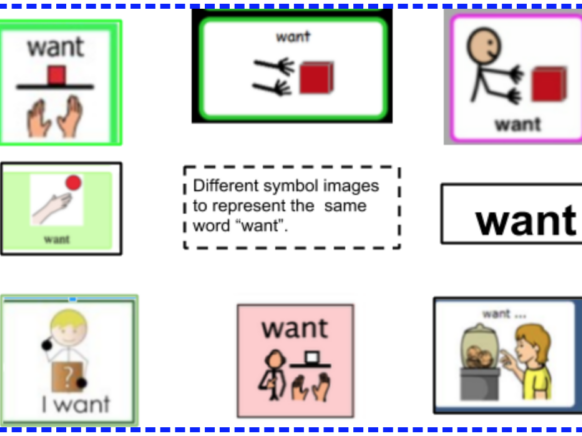As an instructor for EdTechTeacher, I have the pleasure of working with teachers from all over the country. Recently while in California, working with special education teachers, we were exploring how the physical environment impacts student learning. Through our discussion of the physical environment, we began to consider the environmental impact for students with limited or no speech who use augmentative and alternative communication
( AAC ) devices and symbol sets.
The good news is that we have many different options to support expressive and receptive language through AAC symbol sets. These sets can include drawings, photographs, objects, facial expressions, gestures, spoken words, and/or alphabet-based symbols.
Yet, we know as teachers that supporting students’ language development using symbols in the environment needs to be carefully orchestrated. As a group of special educators, we had not anticipated how many different symbol systems and picture sets our students encountered during one school day. During our discussion, we discovered that one child had over four different communication symbol sets to contend with during his day. We quickly discovered that it was not unusual to have children faced with this dilemma. So the question became: how does it help or hurt to have different pictures for the same word each day?
As classroom teams, we need to systematically gather this information to better support our learners. One of the most important aspects in facilitating communication and fostering language growth is to ensure appropriate strategies throughout the student’s day. But what happens when your student encounters several types of pictures for the same word? What are the implications for language development and usage when students are seeing multiple AAC symbol sets and systems?
From an educational perspective, it makes sense to have a consistent symbol set across all environments. Symbols can look similar in various AAC sets. Yet, if we are using multiple symbol sets to represent the same concept, it makes sense that this can impact learning and slow down the process of acquiring communication for our early adopters.
Example: Different symbols representing the same word “want.”

When we use one way of representing the word “want” on the student’s communication device and another way during morning meeting, or low tech communication boards, therapy sessions and home, it is likely that developing competence with their AAC can be negatively impacted. Symbol sets visually represent language, but how does different pictures for the same word help or hurt the student? This can be a barrier to learning and impede progress in mastering symbol meaning.
It is important for educators to be aware of these inconsistencies when surrounding students with visual supports to scaffold both receptive and expressive language. The dynamic qualities of communication make it essential for us to continually investigate the tools and strategies we provide for our students each day. We should critically look at the symbols we use to support curriculum and communication opportunities across all environments.
As a classroom team, we need to look critically at the symbols being used across all activities with our students. We shouldn’t assume that representing a word with various symbols is inconsequential. As practitioners, we need to make a thoughtful decision on how words should be represented on expressive communication tools. Selecting a symbol set should be made with data to support it. Providing naturally occurring social and academic interactions supported with appropriate and consistent symbols should be the goal.


